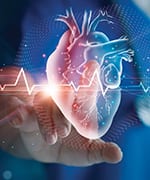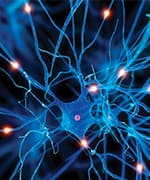Life Extension Magazine®
Normal aging results in a decline in muscle mass and energy production.1,2
This energy deficit has an impact on heart health, cognitive function, and lifespan.2
D-ribose helps restore energy production in the body.3
It is a building block of adenosine triphosphate (ATP), the energy source for every cell.4
By supporting the production of ATP, D-ribose can help replenish the metabolic energy needed by all cells, including those in major organs such as the heart and brain.3
ATP, Energy, and D-Ribose
Energy in the body is produced in the form of adenosine triphosphate, ATP.
This takes place in mitochondria (powerhouse in each cell). ATP is the primary energy source for most biochemical and physiological processes, such as growth, movement and homeostasis.5
Mitochondrial function declines with age5,6 and other health conditions, such as heart failure, among others.3 This results in loss of ATP production and decreased energy levels.3
Hope for Heart Failure
Heart failure means the heart muscle is failing to pump enough blood to meet the body's metabolic requirements.
In heart failure, D-ribose production falls in heart muscle cells.3,7
This leads to a decrease in ATP production, resulting in cellular energy deficiency in the muscle cells of the organs that need energy the most.7
Taking oral D-ribose can help create new ATP molecules and restore cardiac energy levels.7,8
Clinical trials have shown that D-ribose taken orally can improve heart function in heart failure patients.9-11
Lifestyle Modifications to Fight Fatigue18
A constant feeling of tiredness or weakness is called fatigue. It can affect anyone, and most adults will experience fatigue at some point in their life. Some lifestyle modifications that may help:
- Exercise: even a 15-minute walk can give you an energy boost.
- Lose weight if overweight.
- Get optimal sleep.
- Relieve stress: meditate, work out, do yoga, listen to music, have social support.
- Limit alcohol and caffeine intake.
- Stay hydrated.
People with heart failure taking D-ribose were shown to improve blood flow through the heart and body and boost the exchange of oxygen and CO2 through the lungs, leading to improvements in breathing parameters.
Another study showed the ability of D-ribose to reduce symptoms and improve quality of life in heart failure patients.10
In a review of studies in animals and humans, D-ribose has been shown to increase ATP production in heart muscle cells and improve cardiac function.
In clinical trials D-ribose enhanced cardiac function and improved quality of life in patients with heart failure.7
Fibromyalgia
There is evidence that defective production of ATP is the one potential culprit behind fibromyalgia (a condition that causes pain throughout the body)12 and chronic fatigue syndrome.13,14
In an open-label, early study, patients with fibromyalgia or chronic fatigue syndrome took 5 grams of D-ribose three times daily until they reached a total of 280 grams.14
The participants reported significant improvement in all five categories on a standard questionnaire: energy, sleep, mental clarity, pain intensity, and well-being.
On average, patients reported a stunning 45% increase in self-reported energy levels.
Restless Leg Syndrome
Restless leg syndrome is a disorder causing discomfort and pain in the legs. This condition progresses with age and often leads to insomnia. Disordered energy metabolism has been suggested as one possible cause of restless leg syndrome.
Based on that observation, researchers gave individuals with restless leg syndrome 5 grams of D-ribose, three times per day. Remarkably, daytime symptoms werecompletely eliminated, and nighttime symptoms were significantly reduced.15
Exercise Performance
D-ribose is a building block of ATP.3 It may help speed muscle recovery after high-intensity exercise
- In a double-blind cross-over study of 26 athletes, subjects were given either a dextrose sugar control or 10 grams of D-ribose for two days. This was followed by three additional days of supplementation. During these three days, both groups underwent 60 minutes per day of high-intensity exercise. After five days, significant improvement in exercise performance and lower perceived exercise exertion were observed in the D-ribose group, compared to the placebo arm of the study.16
- In a study of healthy, active individuals, supplying fatigued muscle cells with D-ribose quickly restored ATP levels to normal.17
Summary
By restoring the body's ability to produce energy, D-ribose leads to improved function for organs such as the heart and muscles.
D-ribose intake is especially valuable for heart failure patients and has been shown to produce meaningful improvements in cardiovascular function.
Because high doses of D-ribose are needed, most people find it more efficient to take 5 grams or more each day in a neutral-tasting powder form.
What is ATP (adenosine triphosphate)?3,4
- ATP is a molecule carrying energy, found in every cell of the body; it is vital for energy production.
- It has a nitrogenous base (adenine), and a sugar (ribose), attached to three phosphate molecules.
- Cells need energy to perform cellular functions, such as growth, nerve impulse propagation, and muscle cell contraction.
- The energy is stored in phosphate bonds of ATP and is released when these bonds are broken by chemical processes.
If you have any questions on the scientific content of this article, please call a Life Extension Wellness Specialist at 1-866-864-3027.
References
- Walston JD. Sarcopenia in older adults. Curr Opin Rheumatol. 2012 Nov;24(6):623-7.
- Manini TM. Energy expenditure and aging. Ageing Res Rev. 2010 Jan;9(1):1-11.
- Mahoney DE, Hiebert JB, Thimmesch A, et al. Understanding D-Ribose and Mitochondrial Function. Adv Biosci Clin Med. 2018;6(1):1-5.
- Dunn J, Grider MH. Physiology, Adenosine Triphosphate. StatPearls. Treasure Island (FL): StatPearls Publishing Copyright © 2022, StatPearls Publishing LLC.; 2022.
- Brand MD, Orr AL, Perevoshchikova IV, et al. The role of mitochondrial function and cellular bioenergetics in ageing and disease. Br J Dermatol. 2013 Jul;169 Suppl 2(0 2):1-8.
- Chistiakov DA, Sobenin IA, Revin VV, et al. Mitochondrial aging and age-related dysfunction of mitochondria. Biomed Res Int. 2014;2014:238463.
- Krueger KJ, Rahman FK, Shen Q, et al. Mitochondrial bioenergetics and D-ribose in HFpEF: a brief narrative review. Ann Transl Med. 2021 Oct;9(19):1504.
- Pauly DF, Pepine CJ. D-Ribose as a supplement for cardiac energy metabolism. J Cardiovasc Pharmacol Ther. 2000 Oct;5(4): 249-58.
- Bayram M, St Cyr JA, Abraham WT. D-ribose aids heart failure patients with preserved ejection fraction and diastolic dysfunction: a pilot study. Ther Adv Cardiovasc Dis. 2015 Jun;9(3):56-65.
- MacCarter D, Vijay N, Washam M, et al. D-ribose aids advanced ischemic heart failure patients. Int J Cardiol. 2009 Sep 11;137(1):79-80.
- Omran H, Illien S, MacCarter D, et al. D-Ribose improves diastolic function and quality of life in congestive heart failure patients: a prospective feasibility study. Eur J Heart Fail. 2003 Oct;5(5):615-9.
- Gerdle B, Ghafouri B, Lund E, et al. Evidence of Mitochondrial Dysfunction in Fibromyalgia: Deviating Muscle Energy Metabolism Detected Using Microdialysis and Magnetic Resonance. J Clin Med. 2020 Oct 31;9(11).
- Myhill S, Booth NE, McLaren-Howard J. Chronic fatigue syndrome and mitochondrial dysfunction. Int J Clin Exp Med. 2009;2(1): 1-16.
- Teitelbaum JE, Johnson C, St Cyr J. The use of D-ribose in chronic fatigue syndrome and fibromyalgia: a pilot study. J Altern Complement Med. 2006 Nov;12(9):857-62.
- Shecterle L, Kasubick R, St Cyr J. D-ribose benefits restless legs syndrome. J Altern Complement Med. 2008 Nov;14(9):1165-6.
- Seifert JG, Brumet A, St Cyr JA. The influence of D-ribose ingestion and fitness level on performance and recovery. J Int Soc Sports Nutr. 2017;14:47.
- Hellsten Y, Skadhauge L, Bangsbo J. Effect of ribose supplementation on resynthesis of adenine nucleotides after intense intermittent training in humans. Am J Physiol Regul Integr Comp Physiol. 2004 Jan;286(1):R182-8.
- Available at: https://www.nhs.uk/live-well/sleep-and-tiredness/self-help-tips-to-fight-fatigue/. Accessed February, 17, 2023.



